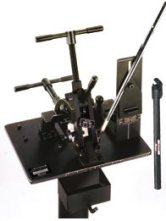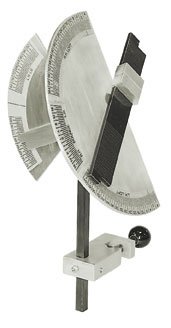Bending Golf Clubs: A Necessity For Lower Scores
by Jeff Jackson, Tour Golf Products
The bending of clubs for loft, lie and face angle is a repair that will often provide a player with immediate quantifiable change in his or her game. Bending lie a few degrees can mean the difference between accurate shots and ones that stray left or right of target. By having progressively consistent lofts, distance gaps are eliminated. Changing the face angle on a metal wood will lead to more fairways hit. Why then, don't all players pay more attention to these key club specifications?
A surprisingly high percentage of golfers do not realize the importance of having proper club specifications. They do not realize that bending a club is among the quickest ways to improve club performance. Some players simply are not aware that clubs are bendable. Many think such bending is only for better players. Let's look at some facts related to club bending and at the same time correct some misconceptions about loft, lie and face angle bending.
Cast clubs can't be bent…
Wrong! In fact, nothing could be further from the truth. More than 80% of all irons produced today are cast, but the question of being able to bend cast clubs is still debated in grill rooms throughout the country. While 17-4 stainless castings will be a bit more difficult to bend as they are harder (C34-38 on the Rockwell Scale) than are 431 (HRC18-25) or carbon steel (high B's on the scale) heads, virtually all castings can be bent. Pings and Callaways can be bent, even though, for some reason, many players seem to think otherwise. To be bendable the iron has to have the proper heat treatment or annealing that will allow bending - let's make the assumption that quality irons indeed have this treatment. Annealing ensures a more consistent grain structure in the metal; heat treatment makes the head hard enough to withstand constant golf ball impacts. We are also assuming the club has a hosel design that will allow bending. Special bending bars may be required for certain hosel designs such as those from Palmer or Cobra, but with proper equipment, nearly all hosel designs can be bent accurately and consistently, improving a golfer's ball flight in the process.
Clubs, like old golfers, have memory…
Wrong again! "Memory" means that once a club is bent, it will somehow return to its original specification. A number of players will tell you that whether this takes a few days, weeks, months or years, the clubs will "spring back" to the specifications they were before bending. This is simply not the case; once a club is set to a given specification, it will stay there until changed by an outside force of either bending again or striking a hard object. Once loft and lie changes are made, they are more or less permanent unless they are forcibly changed in the future.
Metal woods can't be bent… You can't change the loft of a metal wood… |
 |
All #5 irons have the same loft…
An emphatic "NO" to this one! Each manufacturer uses what it calls "standards." The problem is not all companies use the same standards. One company's #5 iron may have 26 degrees of loft, while another's may have 30. Such differences potentially yield a 15-20 yard difference in distance between those two clubs. What you need to be aware of is how consistent the lofts of your clubs are through the set. It would be nice to believe that every set comes from the factory with precise specifications, but we have all seen that is just not the case. Most clubs are mass-produced; there are certain +/- manufacturing tolerances in every factory. You need to make sure all of the clubs in your set have similar increments between them related to loft; you can easily have the lofts and lies set to be progressively consistent from one club to the next with zero tolerance. This will eliminate any distance gaps in your set. Your clubs are now progressively consistent; your distance control should improve significantly.
If I change the loft on my irons, the bounce will change… Lie changes can help correct ball flight… |
 |
Can you be sure that a club will not break during bending…
Not always, but… Even the most skilled club repairmen occasionally break a club. Is this through negligence? Probably not. Most likely the breakage is a result of some type of inconsistency in the metallurgy of the club. Cast clubs may have voids in their internal structure. These voids are effectively weak spots that, if subjected to pressure from bending may fail, contributing to hosel breakage. In addition, the club may not have been heat treated properly, leaving it more brittle than it should be. The hosel of the iron may have been bored off-center, resulting in inconsistent hosel thickness. If bending pressure is placed on a thinner hosel area, breakage can occur. Prior to bending, none of these manufacturing inconsistencies can be identified, making it impossible for the repairman to be wary of bending the club. A properly manufactured club may be bent many times before it breaks. There is no worry that because a club was bent last year (or last week), that bending it again will have any negative effect on it. Most repairmen will mention that they cannot guarantee a club against breakage 100%, so there is a small risk in bending a club. But, based on the performance improvements from proper angle bending, the risk is well worth it!
A club can only be bent 2 degrees…
Wrong again! If the hosel design and manufacturing processes allow, the lie of an iron can be bent more than this with no compromise in the integrity of the head. This is especially true of clubs made with softer carbon steels. Bending lie is very important in achieving consistent accuracy; limiting a player to thinking that 2 degrees is the maximum a club can be bent may limit his playing potential. A high quality bending machine in the hands of an experienced repairman will most often be able to bend a club to accommodate the needs of just about any player.
If you are looking to change your game, a check of the lofts, lies and face angles of your clubs is a great place to start. As you have learned, the specifications of your club may not be what you think they are. Most likely they are not progressively consistent. They might even been adding to your score instead of helping to reduce it. Head to your local pro or repairman for a complete check of your club specs. You might be surprised at what you find - and happy with the results a few changes will make!
